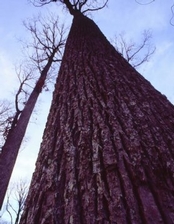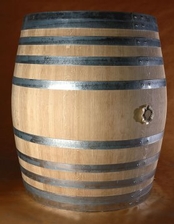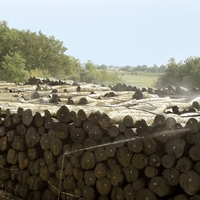Chardonnay is seldom made without it and most red wines seen today on store shelves certainly include it. The French carefully regulate its harvest. Winemakers in other countries covet what the French have and pay dearly for what the French will sell them. Americans work diligently to prove to the world that what they have, at lower prices, is as good as what the French parse out at higher prices.
to prove to the world that what they have, at lower prices, is as good as what the French parse out at higher prices.
The highly-prized commodity is, of course, oak. Over the years, wineries in one country or another have tried to market Chardonnay and the occasional red wine without the wine ever seeing the inside of an oak barrel. The schemes have all pretty much flopped. Even Kendall-Jackson, a California winery known for oaked Chardonnay, recently released a Chardonnay in 2011 called Avant that has just a “kiss” of oak.
Attempts to season wine with an impressive list of woods, some still in use others long since dropped, have been more of an economic and practical success, with oak still the wood of choice for making wine barrels. Wine without oak is not a new trend. A few years back Australian winemakers mounted a half-hearted attempt at making un-oaked Chardonnay. And in the late 1970s, the irascible John Parducci released a Mendocino Cabernet Sauvignon sans oak. Parducci was no fan of wood aging, so he had “Noak” printed in a corner of the front label. “Said what?” yelped Parducci wine lovers. Reluctantly, Parducci dropped “Noak” from the label…and sales soon picked up, leaving Parducci to guess that wine buyers just assumed the wine was oak-aged. This little lesson was proof to some that winemakers are not good marketers.
Such is the pervasiveness of oak in modern wines, a reality that isn’t likely to lessen any time soon. Certain wines of the highest caliber benefit from a symbiotic relationship with oak, but high-end wines make up only a small percentage of wine produced worldwide. The real application is with the bulk of wines, usually pushed by marketing, that are unnecessarily oaked and often over-oaked.
I was going through some papers recently and came across a 1991 article on the growing use of French oak barriques in Italian winemaking by the Italian enologist Giacomo Tachis, creator of Tignanello and noted authority on the wood aging of wine. Although a bit dated, Tachis stated that his main concern is that too many wines are being “forced” into wood when they would be better going directly to glass, or maybe with just a little wood influence. Twenty years later, it would appear that Tachis’ appeal is still being mostly ignored.
Wine marketers have traditionally pushed the mantra, “give the wine  consumers what they want,” but what the public wants is often what marketing says the public wants. Of course it’s not that simple because many factors come into play such as winery economics and wine surpluses. Take the “Two Buck Chuck” phenomenon of a few years back. Conceived as a scheme to deplete wine surpluses, Two Buck Chuck wines were packaged in cork-finished glass bottles, complete with labels and capsules then sold to the Trader Joe’s chain where the wines ran out the door at $1.99 a bottle. The brand name is Charles Shaw, but some savvy Trader Joe’s salesperson began touting the wine as Two Buck Chuck. It was (and is) a classic example of marketing providing a wine at a price the consumer couldn’t ignore.
consumers what they want,” but what the public wants is often what marketing says the public wants. Of course it’s not that simple because many factors come into play such as winery economics and wine surpluses. Take the “Two Buck Chuck” phenomenon of a few years back. Conceived as a scheme to deplete wine surpluses, Two Buck Chuck wines were packaged in cork-finished glass bottles, complete with labels and capsules then sold to the Trader Joe’s chain where the wines ran out the door at $1.99 a bottle. The brand name is Charles Shaw, but some savvy Trader Joe’s salesperson began touting the wine as Two Buck Chuck. It was (and is) a classic example of marketing providing a wine at a price the consumer couldn’t ignore.
As popular as wines like Two Buck Chuck are, they also represent what Tachis meant by “forcing” wine into wood. It’s likely that the Chuck wines were in contact with an oak alternative (chips, blocks, planks) for a short time, but was it necessary for a wine meant to be consumed within days of purchase to be wood aged at all? The success of Two Buck Chuck wines spawned other wines selling for two or three dollars, also cork-finished, with a kiss of oak, that encouraged vintners with access to low-priced wine on the bulk market to jump on the bandwagon.
Today, oak is so commonplace in wine that it’s hard to remember when wines weren’t seasoned with oak or some other wood like chestnut (Italy), redwood (California), acacia, ash and an evergreen beech grown in Chile called rauli. Selecting a type of wood to be used for wine barrels was often based on availability and the reality that local wood was less expensive than importing it from France or the United States. But while wines seasoned by woods like rauli were palatable for the local market, the unusual flavors were alien to consumers more used to the character of French oak and later American and Slovenian oaks.
Most modern consumers prefer Chardonnay with noticeable levels of toasted oak and if given the choice would likely opt for a Cabernet Sauvignon that was aged in French oak or a combination of French and American oak, rather than no oak at all. Blending American and French oaks is an option favored by many New World winemakers today, likely because an American oak barrel costs about half the price of a French oak barrel, but also, in recent years, U.S. cooperages have learned to make wine barrels without the resinous character that marked American oak barrels for so many years. Unlike in France where cooperages made only oak barrels for wine or wine spirits, American cooperages were making whiskey barrels and only later branched out to wine barrels. This move meant adapting to new techniques, a small but significant sign that wine was going mainstream in America.
oak barrels for wine or wine spirits, American cooperages were making whiskey barrels and only later branched out to wine barrels. This move meant adapting to new techniques, a small but significant sign that wine was going mainstream in America.
Even with all the economic and practical barriers blocking the evolution of aging wine in wood, the influence of oak remains an essential part of the wholeness of wine as we enjoy it today. So what is it about the character of oak that makes wine smell and taste better? No other edible food product (except maybe balsamic vinegar) spends months, even years, in oak barrels, drawing the essence of the wood into the wine. It is a seemingly unnatural symbiotic relationship that exists between oak and wine and yet, it works.
Giacomo Tachis stated, “There is a vital lifeline that naturally joins the oak and the vine.” He further notes, “It is the wine that chooses the type of container in which it should or should not be aged.” Referring to red wine, he explained, “In plain words, the wine must have a good bearing structure of noble tannins…and it must be rich in other extractive substances yielded by the skins which have properly macerated during fermentation.” In other words, if a wine doesn’t have the right stuff, it doesn’t belong in oak.
When Tachis wrote the piece on oak and wine in 1991, his semi-technical use of terms like “extractive substances” was not language one would use to entice more consumers to drink wine, with or without oak. Tachis believed that extractive substances such as “noble tannins” and other substances extracted from grape skins are essential to good winemaking. He notes that if the process is done right, “the typology of wine…is, indeed an art.”
Of course, as consumers, we don’t need Giacomo Tachis, or any other winemaker, to tell us that oak is an integral part of wine, but like wine itself, the use of oak should be in moderation. Tachis has the last word on the relationship of wine and wood with this caution: “There is something of a tendency to produce ‘wood wine’ and ‘enologist wine,’ but it is true that those who make wine must not be overawed by wood.”
